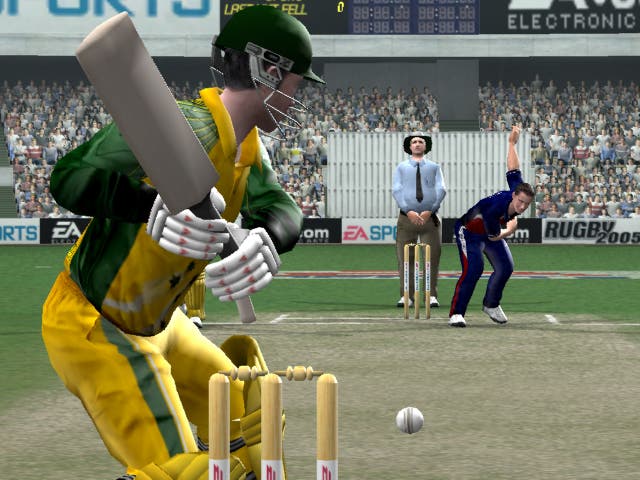Cricket 2005
What a magnificent shot! No, he's out.
Cricket. Fascinating sport. Fun to watch in person even if you don't understand it. Fun to play with some friends even if you don't understand it. Increasingly enthralling to play and watch in any context the more you do understand it.
Cricket 2005. Fascinating game. Funny to see in person because it's full of comical graphical and technical problems and the scores are all "mid-90s England squad" bad. Incredibly difficult to play whether you understand it or not. Only likely to prove enthralling if you're the sort of person who enjoys programming satellite navigation systems using a harpsichord.
It's completely baffling when you first fire it up. Cricket's obviously a complex sport and this is a new way to play it, yet there's no tutorial, so getting to grips with the way it works is a drawn out and frustrating process, and would be near-impossible if your cricketing experience only went as far as whacking a tennis ball around the park or mimicking the chaps on TV without understanding any of the lingo. Don't know your off-stump from your leg-stump? You might as well give up now.
Granted, HB Studios is making a sports simulation, so its audience should be expected to understand the basics, but good sports simulations are fun for all and better for the people who understand them fully. Golf's a good example. A lot of people who love the Tiger Woods PGA Tour series understand the sport better for playing it, or even feel like taking it up as a result, despite having known little about it in the first place beyond the obvious stuff they picked up from a muted telly image of The Open on a lazy Sunday afternoon. Tiger made clever, entertaining mechanics out of a difficult sport. Cricket 2005 doesn't do this. It makes irritating, indecipherable and ineffective mechanics out of an already difficult sport and then has the commentators chide you in despairing tones whenever you make a mistake. Which is 90 per cent of the time.

When bowling, you press the button corresponding to the little icon that represents your preferred delivery (out-swinger, in-swinger, straight, bouncer, etc.), use the analogue stick to target a spot on the ground for the bounce, and then hit the button again as a power-bar fills up to select the pace. This gives you the chance to vary it and confuse the batsman, but you also have to worry about the marker straying into the "no ball" area of the meter, while you're simultaneously judging how much spin to add with the left analogue stick. Bowl well enough and you build up a power meter that lets you wheel out special deliveries like the Yorker, or the, er, slower ball. Is it really that hard to bowl slowly?
Except you don't have much luck whether you learn this stuff by heart or not. The idea is to bowl the same safe-ish delivery repeatedly to little or no effect and then randomly vary it. This sometimes works, but is hugely boring. Inherent to the sport? Arguably. Is that your problem? No. If it felt like a clever, well-judged breakthrough when it does work then it might be something to slightly commend, but it doesn't even make that impression. Having had virtually no luck over the course of painfully dispatching five Canadian batsmen, we enjoyed our best spell after accidentally picking a batsman to continue the bowling assault; his ham-fisted attempts to bowl invariably leading to a dramatic shots from the batsman that swept across the screen toward the same fielder who then caught literally four batsmen in a row.
Instead of a tutorial, there's a Training Nets section to try and teach you about the intricacies of playing cricket. This lets you practice the techniques briefly outlined in the manual and then tells you roughly what you did wrong. "Roughly" is the operative word here. No matter how many times we directed our right-arm medium-fast bowler to deliver the ball in line with or just outside the off-stump, as instructed, wickets were not forthcoming. Despite the fact it even looked like we were doing the right thing every single time. The voice-over just maddeningly repeated the same basic instruction after every delivery. Literally 50 times in a row. That isn't even exaggeration. In a match context, you don't get the advice; you just get told you're an idiot.

Batting is a simpler affair in terms of button presses. Once you've positioned the batsman in the crease, just wait for the delivery and then use the analogue stick and a face or shoulder button in tandem to play your preferred shot. But the lack of on-screen instruction and the confusing number of potential strokes means that keeping the manual open on your lap is a must for the first few hours. Even this isn't going to help you much. If you don't play the defensive stroke most of the time, you get bowled or caught. If you try to dash between the wickets off a ball played short, you almost always get run out. You could argue that this is a question of poor judgement on the part of the player, but we've been playing Cricket 2005 for absolutely ages and we get run out so much it's depressing.
At least the variety of strokes you can play is quite exciting. You can step onto the front or back foot and then apply one of eight techniques, or step away from the ball in the case of bouncers and the like, and were it possible to actually play any of the strokes without getting caught or bowled most of the time then Cricket 2005 could be slogger-central. It seems bizarre that EA's chosen dev team, HB Studios, didn't pay more attention to the excitement that its cover star Freddie Flintoff stirs in spectators with his grandstanding performances and instead made a game where a solid defence is paramount because virtually nothing else works.
That's not even everything we have to say about batting. For example, why on earth can you only move the batsman along the crease up to the point at which it becomes useful? Being able to step side to side to play strokes is critical. Cricket 2005 simply doesn't support this. Oh, and did we mention that most of the camera angles will obscure your view of where the red marker that shows where the ball's going to bounce? We probably should.

We were tempted to leave off reviewing Cricket 2005 until we could put it into context with what's destined to be its main rival, Codemasters' forthcoming Brian Lara International Cricket, but having spent a large number of very long and frustrating hours in its company there doesn't seem much point. There are good ideas here, all the usual official trimmings, and we dare say that given an entire five-match five-day test series' worth of play time it might be possible to just about edge past a total of 100 runs in an innings. But instead most of the games you play in the first few hours seem to end with fewer runs than wickets, and most of the rest of the game is incredibly tedious whether you're "succeeding" or not. Not content with that, it's full of all the usual tenets of one of EA's lower-budget sports titles - irritatingly clunky menuing, stuttering animation, and illogical routines that see batsmen at the bowler's end actually standing outside the crease more or less throughout.
Making a good game of a sport with as much subtlety and inherent inactivity as cricket must be a very difficult job. But you spend your money to be entertained, and this isn't entertaining. Even at that, spending your money to reward the effort here would be a decision you had to think long and hard about. Given the sunny weather at the moment, we'd recommend you go outside and either watch or play cricket instead.

